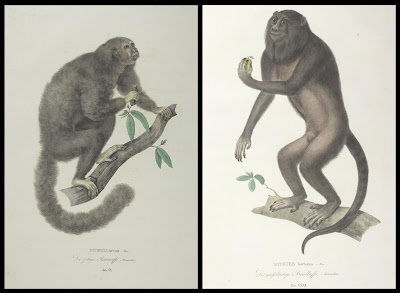

Zoologist, Johann Baptist von Spix, and botanist, Carl Friedrich Philipp von Martius were sent as part of an official Austrian scientific expedition to Brazil to coincide with a marriage between a Bavarian princess and Portuguese Prince who would later become the King of Brazil.
"From 1817 to 1820, traveling separately or together at different stages, Spix's and Martius's explorations in the interior of the country turned out to be one of the most important scientific expeditions of the 19th century. Despite illnesses and harrowing obstacles Spix went up the Amazon River and through its jungles as far as the frontier with Peru.Included among the many publications was Spix's 1823 book, 'Simiarum et Vespertilionum Brasiliensium Species Novae', online at the Smithsonian Institution. The 38 plates are very often stylised, with the addition of human facial features, but are not quite as outlandish as the fanciful pictures Schreber published in the 1770s - seen in a previous post. Coincidentally, Martius was good friends with Schreber, and although a few of the above images seem familiar to me (probably from compilations), none were obviously copied from Schreber's books.
They were the first Europeans to explore these areas since La Condamine in the 1730s/40s , and "their collections - including 85 species of mammals, 350 species of birds, nearly 2,700 species of insects, and fifty-seven living animals - provided material for a vast number of works," as the Dictionary of Scientific Biography notes."
- Carl Friedrich Philipp von Martius was responsible for the massive 'Flora Brasiliensis', published over 60 years up to 1906. See: The Martius Project.
- University of South Carolina 19th century travel books about Brazil.
- 'Johann Baptist Ritter von Spix: primeiro zoólogo de Munique e pesquisador no Brasil' (portuguese).
- Johann Baptist Ritter von Spix (german).
- Cyanopsitta spixii (Spix's macaw), possibly the rarest bird in the world, is now extinct in the wild. See: i, ii, iii, iv, v, vi.








































































8 comments :
Those bats are really well-done! I wish they were each rendered larger, like the primates, which have such varied and mischievous facial expressions. The bats look slightly diabolical, but it's hard to tell.
Agreed on the bats, they look impressively much like the taxidermy kind although I'm sure live ones are a bit fluffier.
Hi there,
u have a very interesting blog. i would like to ask u a few q's. where can i mail u?
athena, I left an answer on your blog yesterday but in case you didn't realise it was me..
peacay#gmailDOTcom
where # = @
and DOT = .
(and yeah, I wished for high def bats too. Beggars and all that..)
Hi peacay-
just letting you know that this one got an effpeepee at MoFi. As you should have expected, I suppose!
-fish tick
Thanks fish tick! I did espy a telltale inbound link a while ago. It was playing to a captive audience really.
: )
Paul, I just discovered your blog. It is insanely great. Thanks for the great images.
BTW: When you get a chance, check out my blog: http://anonymousworks.blogspot.com/
Thanks,
Joey.
Post a Comment
Comments are all moderated so don't waste your time spamming: they will never show up.
If you include ANY links that aren't pertinent to the blog post or discussion they will be deleted and a rash will break out in your underwear.
Also: please play the ball and not the person.
Note: only a member of this blog may post a comment.